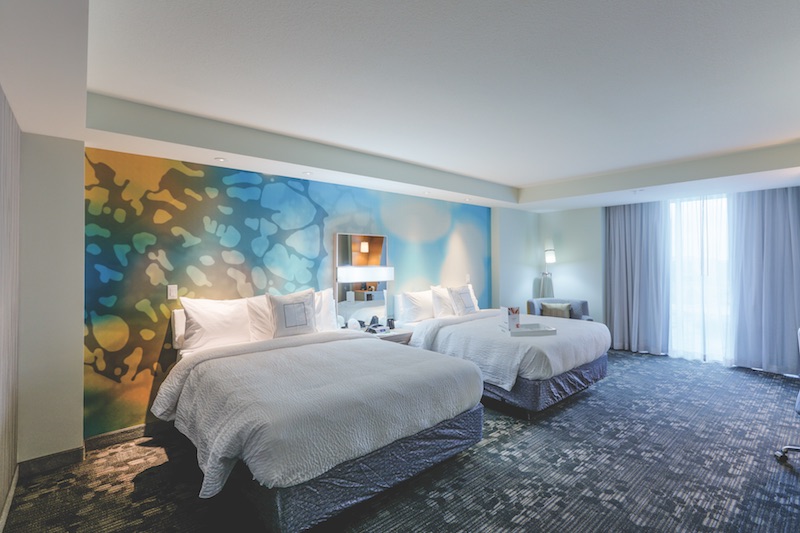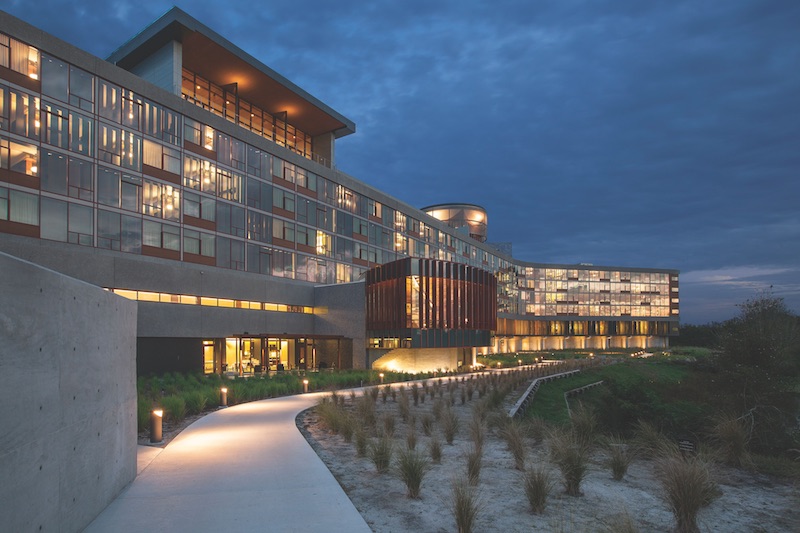The $12.2 billion merger of Marriott International and Starwood Hotels & Resorts reflects an industrywide consolidation that has placed the keys to millions of the world’s hotel rooms into the hands of a few hospitality companies.
But rather than narrowing consumer options, this consolidation has actually had the opposite effect. The number of hotel brands and sub-brands continues to multiply, expanding at a breakneck pace as the largest hospitality players seek to attract and build loyalty with guests. Collectively, Marriott and Starwood now oversee 30 separate hotel brands, ranging from signature flags like Ritz-Carlton to newer select-service boutique brands such as Aloft, which targets global travelers.
“Ten years ago, prototypical brands were very consistent from market to market,” says Nate Gundrum, Director of Real Estate Development with Mortenson Construction. “Now, with the addition of new brands, you’re seeing larger hotel companies opening up to the idea of customizing a hotel to its site, neighborhood, and market rather than following a cookie-cutter approach where every brand had to look the same.”
With a vast assortment of choices, hotel providers aim to offer consumers a customized lodging experience that aligns with their lifestyle and budget.
“For the longest time, it was all about repetition and economies of scale,” says Keith Simmel, AIA, LEED AP, Principal of the Hospitality Studio at Cooper Carry in Atlanta. “Even though those things are still very important, we’re weaving more and more local flavor into a hotel so that it creates an experience unique to a specific place.”
That local experience is about far more than just offering trendy local cuisine or kitschy T-shirts in the gift shop. The 800-room Omni Nashville hotel, designed by HKS, is seamlessly integrated into the Country Music Hall of Fame and Museum on three levels. In the lobby area, visitors can view colorful posters being designed and printed at a production shop and gallery operated by Hatch Show Print Company, a local printer.
“Hotels have an opportunity to create a soulful experience that grounds itself in a place and leaves an indelible memory with guests,” says Nunzio DeSantis, FAIA, LEED AP, Director of the HKS Hospitality Group in Dallas. “And it isn’t just limited to the public spaces. It could be the way the guest room is fashioned, the quality of light, the materials, or the overall tenor of the space.”
To broaden a hotel’s appeal to multiple market segments, hotel developers are increasingly choosing to co-locate two or more complementary brands within the same hotel complex. At The Wharf, a $2 billion mixed-use waterfront community in Washington, D.C., a dual-branded hotel under construction combines a Canopy by Hilton and a Hyatt House into a dual-branded hotel with shared amenities.
“They’re two different flags, but not really in competition with each other,” says John Crump, AIA, LEED AP, Workplace Studio Leader at SmithGroupJJR in Washington, D.C. “Canopy is a select-service brand targeted to Millennials and single travelers and Hyatt House appeals to a business traveler or as an extended-stay hotel. The arrangement works well because people have access to the same amenities within the facility, but they can retire back to their rooms to meet their specific lodging requirements.”
 The 19-story Westin Austin Downtown is home to the city’s tallest hotel rooftop pool and bar, featuring cabanas, a fire pit, and a 24-hour fitness studio. The hotel draws design inspiration from the local music scene. The project is a joint venture among White Lodging Services Corp., the Harry Whittington family, and REI Real Estate Services. Photo: HKS Hospitality Group.
The 19-story Westin Austin Downtown is home to the city’s tallest hotel rooftop pool and bar, featuring cabanas, a fire pit, and a 24-hour fitness studio. The hotel draws design inspiration from the local music scene. The project is a joint venture among White Lodging Services Corp., the Harry Whittington family, and REI Real Estate Services. Photo: HKS Hospitality Group.
A SHIFTING OF SPACE
Rising real estate costs and evolving guest preferences are inspiring a reshaping of hotel layouts to make the most productive use of interior space. Generally, guest rooms are getting smaller, while public spaces are increasing in size—a phenomenon similar to the office sector’s trend toward less “me” space and more “we” space.
“Guest rooms are where people sleep and get cleaned up to go out and experience whatever place they’re visiting,” says Caleb Mulvena, Principal at Mapos in New York. “We want the common spaces to help enhance that experience.”
Nowhere is this shift more apparent than in the hotel lobby, which has transformed from a narrow-use area that accommodates arrival and check-in activities to a dynamic living-room space and hub of diverse activity.
“We joke in our office that it’s not your parent’s Marriott hotel lobby anymore,” Simmel says. “It’s really a social gathering space, a social condenser.”
Lobbies are vital to maximizing revenue generation through a growing focus on food and beverage offerings. Cooper Carry capitalized on this trend with its 2016 acquisition of The Johnson Studio, an Atlanta-based restaurant designer. Their recent design collaborations include a new 325-key luxury hotel and conference facility under construction in Alpharetta, Ga. A restaurant forms the centerpiece of the lobby at this property, which anchors the city’s 1.1 million-sf Avalon mixed-use development.
Fitness centers also have been elevated from their traditional locations tucked away in a basement to prominent positions with generous square footage and scenic views to the outside. And rooftops are being repurposed into active amenity spaces.
“Rooftops are becoming one of the most important landscapes in the hotel,” says DeSantis. “They’ve also become some of the most active revenue-generating assets, whether they house bars, restaurants, meeting space, outdoor entertainment zones, or a pool.”
Technology continues to streamline the guest experience, from the efficient check-in and check-out process to the robust wireless infrastructure that supports seamless use of laptop and mobile devices.
“The days of running cable are gone,” says Rick Goldman, District Manager with PCL Construction in Orlando, Fla. “Now it’s more about knowing how much wireless capacity is enough.” Determining the amount of bandwidth required can be difficult, says Goldman, “as hotels are having to accommodate families of five, with each person having a device, sometimes two.”
Some hotels are striving to distinguish themselves by offering technology-centric amenities such as mobile tablets in guest rooms, while others are focused on providing a reliable technology infrastructure.
“Most people just want a clean room that accommodates a digital lifestyle. Give them high-speed WiFi and a place to charge their devices, and they’re off to the races on their own,” says Mulvena. “It’s really about creating hotels that deliver highly ‘Instagrammable’ experiences that people will have fun sharing.”
 Stay Well guestrooms at the Lake Nona Residence Inn and Courtyard hotels in Orlando, Fla., provide evidence-based health and wellness features, including circadian lighting, air purifiers, filtered water, acoustic enhancements, and low-VOC materials that limit the emission of toxins and chemicals. MacBeth Photography, Courtesy Cooper Carry.
Stay Well guestrooms at the Lake Nona Residence Inn and Courtyard hotels in Orlando, Fla., provide evidence-based health and wellness features, including circadian lighting, air purifiers, filtered water, acoustic enhancements, and low-VOC materials that limit the emission of toxins and chemicals. MacBeth Photography, Courtesy Cooper Carry.
REPOSITIONING EXISTING PROPERTIES
To keep pace with the flurry of new hotel properties coming online, existing properties are reimagining their facilities to enhance their appeal to potential guests.
“Some of the most interesting work is on major renovations of landmark hotels or hotel conversions from a completely different building type,” says Randa Tukan, IDC, LEED AP BD+C, Director of Interiors at HOK in Toronto. “Many of these projects involve a major rethinking of the space available, which makes the solution a lot more interesting and unpredictable.”
HOK recently completed a $180 million renovation of the Intercontinental New York Barclay, a luxury hotel that originally opened its doors in 1926 as part of the Grand Central Terminal expansion. “Within this historic space, we were able to carve out a lot more public spaces by repurposing house spaces and storage spaces into new multipurpose areas,” Tukan says.
Creating a sense of surprise is a priority for many hotel developers, adds Tukan. “A few years ago, a sense of familiarity was important for helping people feel more secure,” she says. “The trend now is the complete opposite. Because of our constant exposure to new ideas and information—real or virtual—we all yearn for experiences that are fresh and different.”
In Orlando, the Lake Nona Residence Inn and Courtyard hotel development was under construction when Tavistock Development decided to convert a floor of both hotels to Stay Well guest rooms. Introduced by Delos, creator of the WELL Building Standard, these hypoallergenic rooms offer evidence-based health and wellness features to help travelers live healthy lives while on the road. Amenities include circadian lighting, air purifiers, filtered water, acoustic enhancements, and low-VOC materials that limit the emission of toxins and chemicals.
“These hotels are located a short walk from a large children’s hospital and a VA hospital, so the developer saw this as a way to promote healthiness in an area where people were already acutely aware of health components,” Simmel says.
In many ways, today’s hotels are recommitting to their fundamental mission of providing exceptional service to guests.
“There seems to be a return to hospitality in the hospitality industry,” says SmithGroupJJR’s Crump. “Hotels have always strived to provide an environment of welcoming guests and giving them a great experience, but I think that’s been lost over the years, so brands are refocusing on enhancing the overall guest experience.”
Related Stories
| Aug 11, 2010
Florida mixed-use complex includes retail, residential
The $325 million Atlantic Plaza II lifestyle center will be built on 8.5 acres in Delray Beach, Fla. Designed by Vander Ploeg & Associates, Boca Raton, the complex will include six buildings ranging from three to five stories and have 182,000 sf of restaurant and retail space. An additional 106,000 sf of Class A office space and a residential component including 197 apartments, townhouses, ...
| Aug 11, 2010
America's Greenest Hospital
Hospitals are energy gluttons. With 24/7/365 operating schedules and stringent requirements for air quality in ORs and other clinical areas, an acute-care hospital will gobble up about twice the energy per square foot of, say, a commercial office building. It is an achievement worth noting, therefore, when a major hospital achieves LEED Platinum status, especially when that hospital attains 14 ...
| Aug 11, 2010
3 Hospitals, 3 Building Teams, 1 Mission: Optimum Sustainability
It's big news in any city when a new billion-dollar hospital is announced. Imagine what it must be like to have not one, not two, but three such blockbusters in the works, each of them tracking LEED-NC Gold certification from the U.S. Green Building Council. That's the case in San Francisco, where three new billion-dollar-plus healthcare facilities are in various stages of design and constructi...
| Aug 11, 2010
Westin Hotel
Mid-twentieth-century projects are in a state of limbo. In many cities, safeguards against quick demolition don't even cover “new” buildings built after 1939, yet many such buildings may be obsolete by current standards. The Farmers and Mechanics Savings Bank, located in downtown Minneapolis, was one such building, a rare example of architecture from a time when American design was ...
| Aug 11, 2010
Platinum Award: Monumentally Hip Hotel Conversion
At one time the tallest building west of the Mississippi, the Foshay Tower has stood proudly on the Minneapolis skyline since 1929. Built by Wilbur Foshay as a tribute to the Washington Monument, the 30-story obelisk served as an office building—and cultural icon—for more than 70 years before the Ryan Companies and co-developer RWB Holdings partnered with Starwood Hotels & Resor...
| Aug 11, 2010
Hilton President Hotel
Once an elegant and fashionably trendy locale, the Presidential Hotel played host to the 1928 Republican National Convention where Herbert Hoover was nominated for President, and acted as a hot spot for Kansas City Jazz in the '30s and '40s. The hotel was eventually abandoned in 1984, at which point it became a haven for vagabonds and pigeons, collecting animal waste and incurring significant s...
| Aug 11, 2010
CityCenter Takes Experience Design To New Heights
It's early June, in Las Vegas, which means it's very hot, and I am coming to the end of a hardhat tour of the $9.2 billion CityCenter development, a tour that began in the air-conditioned comfort of the project's immense sales center just off the famed Las Vegas Strip and ended on a rooftop overlooking the largest privately funded development in the U.
| Aug 11, 2010
The softer side of Sears
Built in 1928 as a shining Art Deco beacon for the upper Midwest, the Sears building in Minneapolis—with its 16-story central tower, department store, catalog center, and warehouse—served customers throughout the Twin Cities area for more than 65 years. But as nearby neighborhoods deteriorated and the catalog operation was shut down, by 1994 the once-grand structure was reduced to ...
| Aug 11, 2010
Great Solutions: Healthcare
11. Operating Room-Integrated MRI will Help Neurosurgeons Get it Right the First Time A major limitation of traditional brain cancer surgery is the lack of scanning capability in the operating room. Neurosurgeons do their best to visually identify and remove the cancerous tissue, but only an MRI scan will confirm if the operation was a complete success or not.
| Aug 11, 2010
Gold Award: Westin Book Cadillac Hotel & Condominiums Detroit, Mich.
“From eyesore to icon.” That's how Reconstruction Awards judge K. Nam Shiu so concisely described the restoration effort that turned the decimated Book Cadillac Hotel into a modern hotel and condo development. The tallest hotel in the world when it opened in 1924, the 32-story Renaissance Revival structure was revered as a jewel in the then-bustling Motor City.







